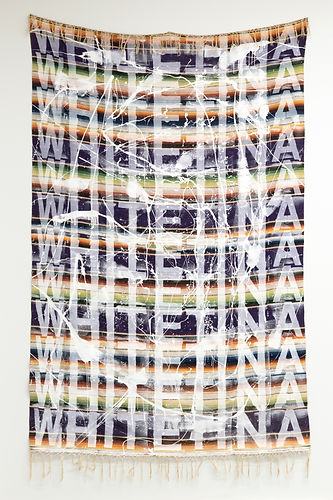
Exploring Kelly Chuning's "Mestiza"
By Etta Harshaw
Kelly Chuning explains that when her mother's side of her family moved to the U.S. they heavily assimilated to white American culture. The lack of her own culture in her surroundings contributed to a sense of imposter syndrome; the artist had difficulty identifying with her own ethnicity. Having been home schooled, and the only members of her family who spoke Spanish being her maternal grandparents, Chuning often felt that it was not her place to have conversations about the Chicana experience.
One object in from Chuning's upbringing resonated with her as a symbol of her Mexican heritage: the serape. The historic Mexican textile is a product of both European and Indigenous techniques, and their presence in the U.S. traces back to the Mexican American War, when American Soldiers would take them back as souvenirs. This complex history connected to the colonization of the Americas by Europeans and to the conflicts between Mexico and the United States furthers Chuning's relationship with the object as a symbol of her mixed Latinx and Caucasian ethnicity. As the popularity of the serape grew in the United States in the 20th century, the production of the object was outsourced and subjected to mass production in both cotton and wool, rather than the traditionally hand woven wool. Chuning collected vintage serapes for this project in hopes of repurposing traditional materials that had been weathered and naturally worn.
Chuning then began to reflect on and research terms that have been used to describe her and fellow Chicanas. She painted these phrases repeatedly in a similar sans serif to her series “It’s All Just Talk,” a typeface which may remind the viewer of Barbara Kreuger or Jenny Holzer, on her collection of vintage serapes in latex house paint. While the paint was a natural choice to the artist, as she is inherently connected to it through her family’s work in construction, she has added splatters and drips to reference Jackson Pollock (who used the same paint on canvas) and Abstract Expressionism (AbEx), which is considered the beginning of Modern art, but consisted almost entirely of white men. While Pollock, one of the most prolific painters to this day, was the image of the American Southwest at the peak of his career, in this series Chuning provides a different idea of the American Southwest, one that reflects her lived experience as a Chicana in Utah and Southern California. While Chuning references Pollock in material and style, her incorporation of text and textiles creates a layered commentary on a minority experience, an important political statement the likes of which the AbEx action painter could never have examined.


